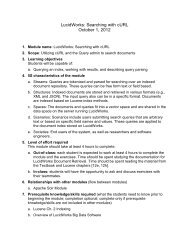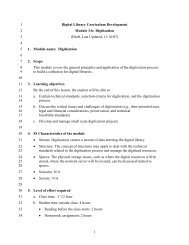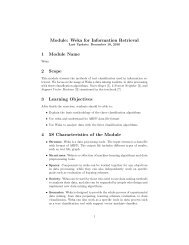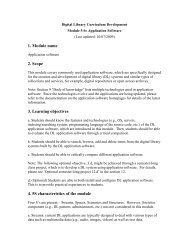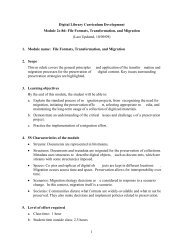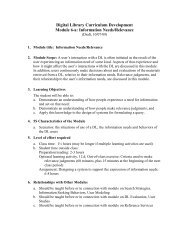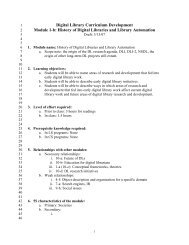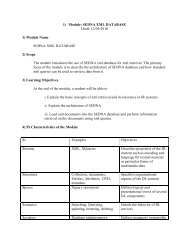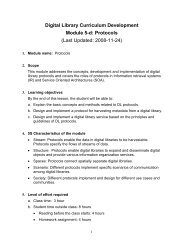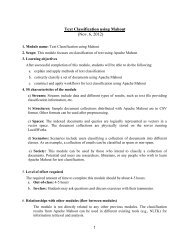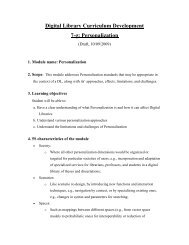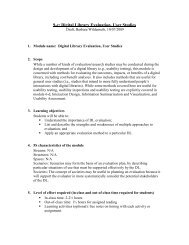Digital Library Curriculum Development Module 1-b: History of ...
Digital Library Curriculum Development Module 1-b: History of ...
Digital Library Curriculum Development Module 1-b: History of ...
You also want an ePaper? Increase the reach of your titles
YUMPU automatically turns print PDFs into web optimized ePapers that Google loves.
. Weak relationships:i. 4-e: Object description and organization for a specific domain: <strong>Module</strong>4e should follow module 1-b. Students should understand the historicaldevelopment <strong>of</strong> domain-specific DLs.ii. 7-a: Indexing and searching: Students should understand that the field<strong>of</strong> IR was one <strong>of</strong> the fields that strongly influenced the early history <strong>of</strong>DLs.iii. 4-a: Information Architecture: Students should understand that thefield <strong>of</strong> hypertext was one <strong>of</strong> the fields that strongly influenced theearly history <strong>of</strong> DLs.7. Prerequisite knowledge required:a. In LIS programs: Noneb. In CS programs: None8. Introductory remedial instruction:a. None9. Body <strong>of</strong> knowledge:a. Research streams that fed into early DL worki. Information Retrieval:1. DLI emerged largely out <strong>of</strong> the IR community2. First significant agenda-setting discussion <strong>of</strong> DLs was theNSF-sponsored Invitational Workshop on Future Directions inText Analysis, Retrieval and Understanding in October 1991,held preceding the 1991 ACM Special Interest Group onInformation Retrieval (SIGIR) conference.ii. High-performance computing & Cyberinfrastructure1. DLI was a subcomponent <strong>of</strong> the High-Performance Computingand Communications Initiative, established under the High-Performance Computing Act <strong>of</strong> 1991.iii. OPACs and library automationiv. Electronic publishing & Scholarly publishing1. Many DL projects began as publishing efforts. E.g.,a. Elsevier Science’s The University Licensing Project(TULIP) projectb. Association for Computing Machinery (ACM)’s digitallibrary activities began with explorations into electronicpublishing, including <strong>of</strong> hypertexts, and support <strong>of</strong> theNSF-funded Envision project at Virginia Techv. Hypertextvi. Databases: text & multimedia2
10. Resourcesa. Required readings:i. Wattenberg, F. (1998). A National <strong>Digital</strong> <strong>Library</strong> for Science,Mathematics, Engineering, and Technology Education. D-LibMagazine, 4(9). http://dx.doi.org/cnri.dlib/october98-wattenbergii. Griffin, S. M. (1998). NSF/DARPA/NASA <strong>Digital</strong> Libraries Initiative:A Program Manager's Perspective. D-Lib Magazine (July/August).http://dx.doi.org/cnri.dlib/july98-griffiniii. Greenstein, D., & Thorin, S. E. (2002). The <strong>Digital</strong> <strong>Library</strong>: ABiography (No. 109). Washington, DC: Council on <strong>Library</strong> andInformation Resources.http://www.clir.org/PUBS/reports/pub109/pub109.pdfb. Research streams that fed into early DL worki. Information Retrieval1. Fox, E. A. (1993). Source Book on <strong>Digital</strong> Libraries, Version1.0. Blacksburg, VA: Virginia Tech.http://fox.cs.vt.edu/<strong>Digital</strong><strong>Library</strong>/DLSB.pdf (Specificallychapters 1, 2, & 3)ii. High-performance computing & Cyberinfrastructure1. Kahn, R. E., & Cerf, V. G. (1988). The <strong>Digital</strong> <strong>Library</strong> ProjectVolume I: The World <strong>of</strong> Knowbots (DRAFT): An OpenArchitecture For a <strong>Digital</strong> <strong>Library</strong> System and a Plan For Its<strong>Development</strong>: Corporation for National Research Initiatives.http://hdl.handle.net/4263537/20912. Atkins, D. E., Droegemeier, K. K., Feldman, S. I., Garcia-Molina, H., Klein, M. L., Messerschmitt, D. G., et al. (2003).Revolutionizing Science and Engineering ThroughCyberinfrastructure: Report <strong>of</strong> the National Science FoundationBlue-Ribbon Advisory Panel on Cyberinfrastructure.Arlington, VA: National Science Foundation.http://www.nsf.gov/od/oci/reports/atkins.pdf.iii. OPACs and library automation1. Fenly, J. G., & Wiggins, B. (1988). The Linked SystemsProject: a networking tool for libraries. Dublin, OH: OCLCOnline Computer <strong>Library</strong> Center.iv. Electronic Publishing & Scholarly Publishing1. Bush, V. (1945). As We May Think. The Atlantic Monthly,176(1), 101-108. http://www.theatlantic.com/doc/194507/bush2. Peek, R. P., & Pomerantz, J. P. (1998). Electronic ScholarlyJournal Publishing. In M. E. Williams (Ed.), Annual Review <strong>of</strong>Information Science and Technology (Vol. 33, pp. 321-356).Medford, NJ: Information Today, Inc.v. Hypertextvi. Databases: text & multimediavii. Humanities computing5
viii. User studies & evaluationc. <strong>Digital</strong> <strong>Library</strong> Initiative (DLI)i. Evaluation and critique (also for DLI-2):1. Saracevic, T., & Dalbello, M. (2003). <strong>Digital</strong> library researchand digital library practice: How do they inform each other?http://www.scils.rutgers.edu/~tefko/Saracevic_Dalbello_DLib_02.docd. <strong>Digital</strong> Libraries Initiative Phase 2 (DLI-2)i. DLI-2 website: http://www.dli2.nsf.gov/e. Funding agenciesi. National Science Foundation (NSF)1. Wattenberg, F. (1998). See 10.a.i.2. Griffin, S. M. (1998). See 10.a.ii.ii. Institute <strong>of</strong> Museum and <strong>Library</strong> Services (IMLS)1. Ray, J. (2004). Connecting people and resources: <strong>Digital</strong>programs at the Institute <strong>of</strong> Museum and <strong>Library</strong> Services.<strong>Library</strong> Hi Tech, 22(3), 249-253.iii. Andrew W. Mellon Foundationiv. W.K. Kellogg Foundationf. Major digital library projectsi. Alexandriaii. American Memory1. About American Memory: Mission and <strong>History</strong>.http://memory.loc.gov/ammem/about/index.html2. Anonymous. (1995). LC, ARL Directors Collaborate onNational <strong>Digital</strong> <strong>Library</strong>. <strong>Library</strong> <strong>of</strong> Congress InformationBulletin, 54(1). http://www.loc.gov/loc/lcib/9501/ndl.html3. <strong>Library</strong> <strong>of</strong> Congress. (1995). A periodic report from TheNational <strong>Digital</strong> <strong>Library</strong> Program, No. 2.http://www.loc.gov/ndl/sep-95.htmliii. Perseus1. Crane, G. (1998). The Perseus Project and Beyond: HowBuilding a <strong>Digital</strong> <strong>Library</strong> Challenges the Humanities andTechnology. D-Lib Magazine, 4(1).http://dx.doi.org/cnri.dlib/january98-crane2. Marchionini, G. (2000). Evaluating <strong>Digital</strong> Libraries: ALongitudinal and Multifaceted View. <strong>Library</strong> Trends, 49(2),304-333.6
iv. ibiblio1. Jones, P. (2001). Open(source)ing the doors for contributor-rundigital libraries. Communications <strong>of</strong> the ACM, 44(5), 45-6.v. The National Science <strong>Digital</strong> <strong>Library</strong> (NSDL)1. Wattenberg, F. (1998). See 10.a.i.2. Zia, L. L. (2006). The NSF National Science, Technology,Engineering, and Mathematics Education <strong>Digital</strong> <strong>Library</strong>(NSDL) Program. D-Lib Magazine, 12(3).http://dx.doi.org/10.1045/march2006-inbriefvi. The Networked <strong>Digital</strong> <strong>Library</strong> <strong>of</strong> Theses and Dissertations (NDLTD)1. NDLTD website: http://www.ndltd.org2. Fox, E. A., et al. (1997). Networked <strong>Digital</strong> <strong>Library</strong> <strong>of</strong> Thesesand Dissertations: An International Effort UnlockingUniversity Resources. D-Lib Magazine, 3(8).http://dx.doi.org/cnri.dlib/september97-foxg. Evolution <strong>of</strong> servicesi. Architectural1. Kahn, R., & Wilensky, R. (1995). A Framework forDistributed <strong>Digital</strong> Object Services.http://dx.doi.org/cnri.dlib/tn95-01ii. <strong>Library</strong>-style1. <strong>Library</strong> Trends 49(2), Fall 2000: Special issue: Assessing<strong>Digital</strong> <strong>Library</strong> Servicesiii. Educational1. Giersch, S., Klotz, E. A., McMartin, F., Muramatsu, B.,Renninger, K. A., Shumar, W., et al. (2004). If You Build It,Will They Come? Participant Involvement in <strong>Digital</strong> Libraries.D-Lib Magazine, 10(7/8).http://dlib.org/dlib/july04/giersch/07giersch.html.iv. Support for community development1. Marchionini, G. (1999, September 28-29). Augmenting <strong>Library</strong>Services: Toward the Sharium. Paper presented at theInternational Symposium on <strong>Digital</strong> Libraries, Tsukuba,Ibaraki, Japan.http://www.ils.unc.edu/~march/sharium/ISDL.pdfv. Convergence between DLs & physical libraries11. Concept map7
12. Exercises / Learning activitiesa. Discussion questions: How has the research and development from the field <strong>of</strong>computer science influenced the evolution <strong>of</strong> DLs? From information andlibrary science?b. Small group discussion: Compare & contrast 2 projects from 2 differentinitiatives.c. Write a 2-page case study <strong>of</strong> one specific project: What has that projectcontributed to DLs today?13. Evaluation <strong>of</strong> learning outcomesa. None14. Glossarya. DLI: <strong>Digital</strong> Libraries Initiativeb. DLI-2: <strong>Digital</strong> Libraries Initiative Phase 2c. IMLS: The Institute <strong>of</strong> Museum and <strong>Library</strong> Services. imls.govd. NSDL: National Science <strong>Digital</strong> <strong>Library</strong>, created by the National ScienceFoundation. nsdl.org15. Additional useful links16. Contributorsa. Initial author: Jeffrey P. Pomerantzb. Evaluators: Richard Furuta, Molly Dotson8



